Curtis Michael Gimeno Memorial Scholarship Donor Statement
This scholarship benefits students with a creative writing emphasis who exemplify promise of talent in communicating through the written language, and wish to pursue a career in writing. The scholarship was generously established by Donna Jorgenson Farrell in memory of and as a legacy to her son, Curtis Michael Gimeno, who enjoyed writing.
A Short Biography by Mom
(Donna Jorgenson Farrell, School of Journalism and Mass Communications, CU-Boulder, Class of 1988)
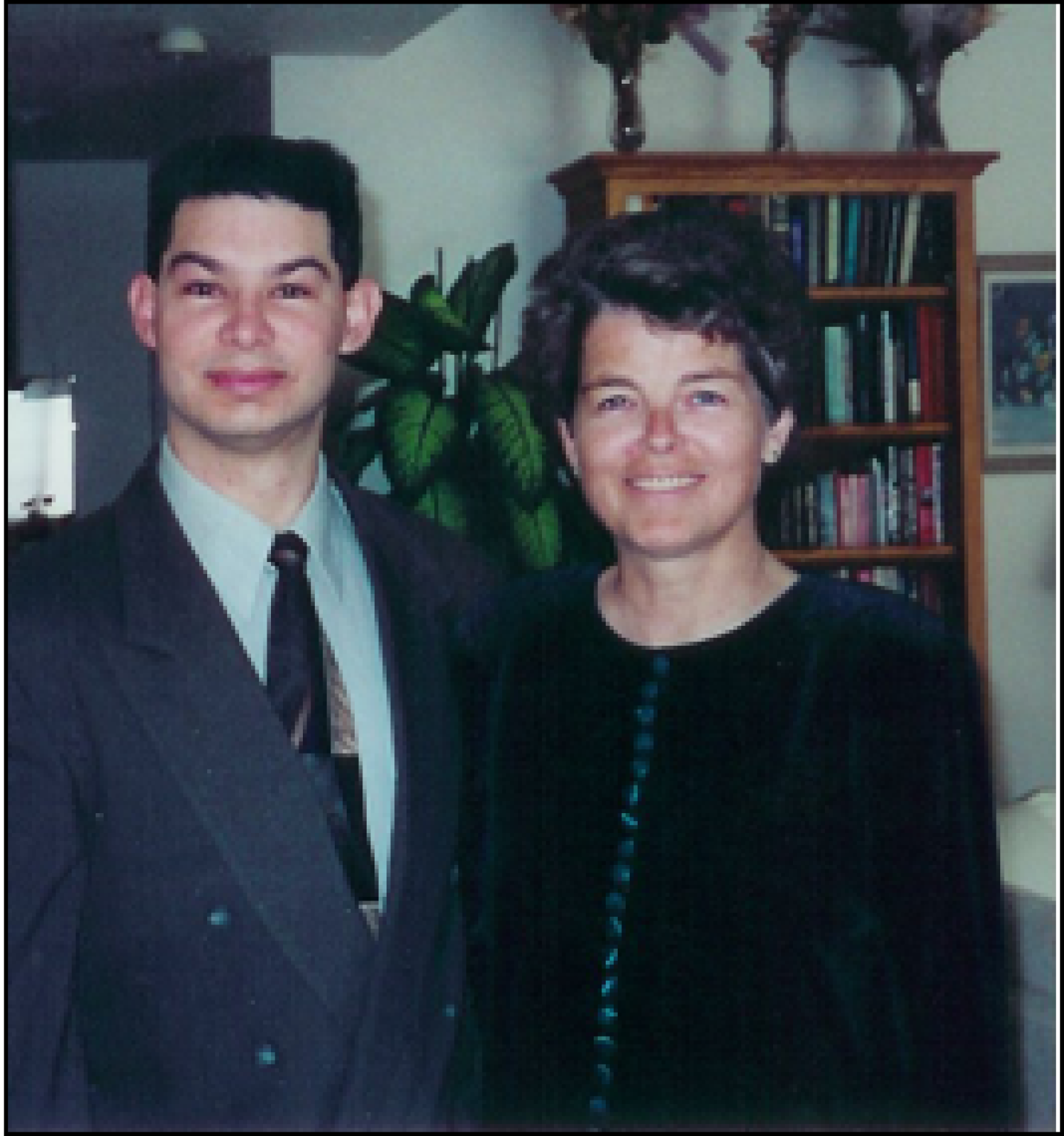
The second-to-the-last material gift Curt gave me was a cross-stitch kit. He bought it for me to work on “during your down time when I’m in the hospital.” Although I worked on it in the hospital while he slept, I didn’t finish it until more than a year after he died. I stitched the bow ties on the little bears in blues instead of the pinks suggested by the pattern, because I wanted them to represent my sons. I know that would have made Curt smile. This cross-stitch hangs on the wall just inside my front door. It is my most prized possession, because Curt told me that when he saw it in the store, he said, “That’s my Mom.”
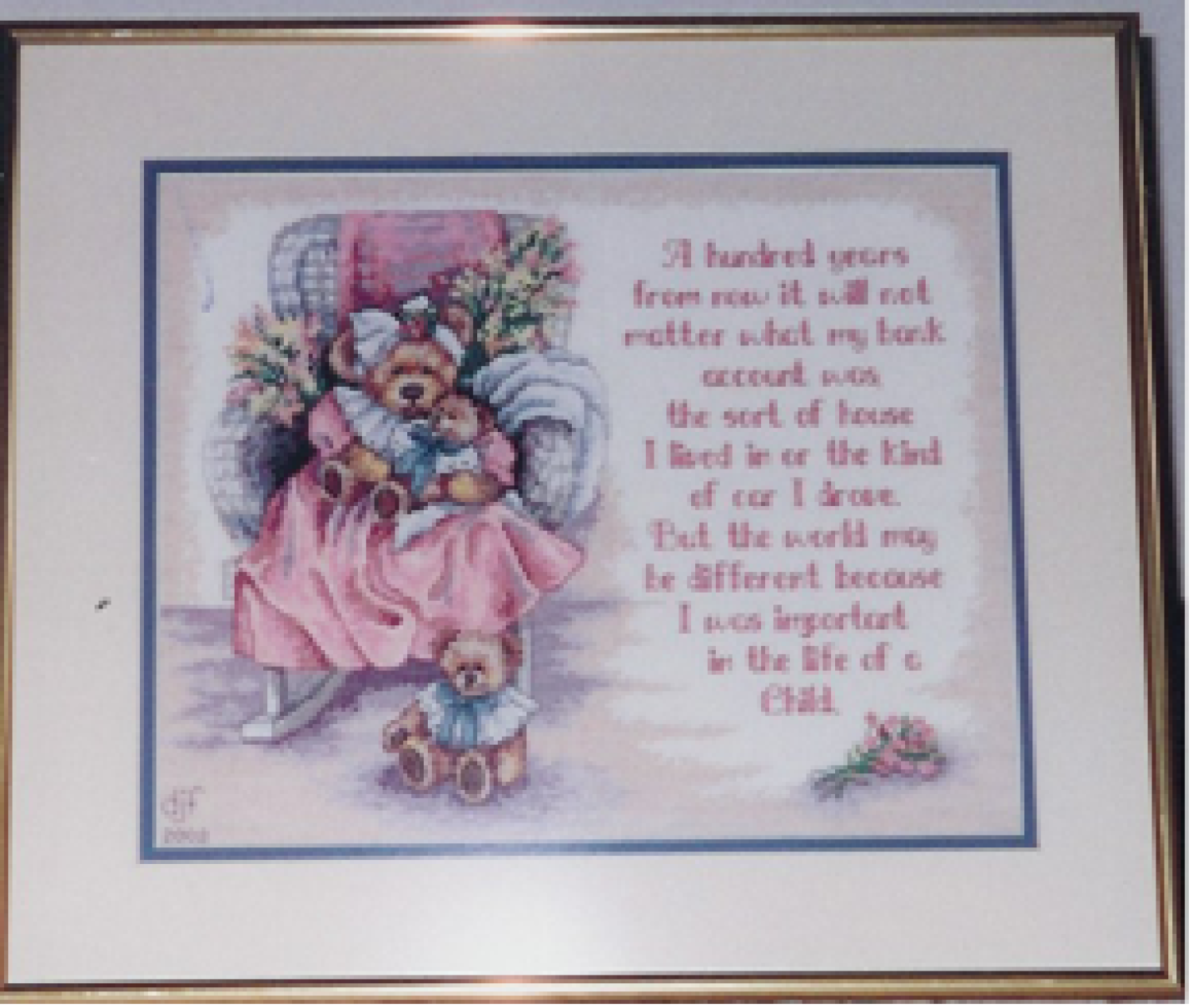
That was Curt, too. He loved children and wanted to make enough money before starting a family so that he could be a stay-at-home dad. He would have been a great father; unfortunately, he had no children.
The last material gift Curt gave me was to name me as beneficiary of the $50,000 life insurance policy carried on him by his employer. I didn’t know about the policy until after his death. When I was notified by the personnel director where he worked, I just understood that he left the money to me because he knew that I am not motivated by money, and he trusted me to do the right thing with it, if the time should come. It honestly didn’t take me very long to figure out what he wanted me to do with it. Reflecting on his life led me to the decision to endow this scholarship.
Recovering from the radiation required for his bone marrow transplant on September 29, 2000, Curt was barely able to communicate. His verbal attempts were mere whispers, as his body sloughed off cells, and it was painful for him to talk. I tearfully told him one morning that he had more courage than anyone I had ever known. I didn’t hear his inaudible response, so I put my ear close to his lips and asked him to repeat what he was trying to say. “Rita,” he whispered again.
“Yes,” I agreed, “Rita had great courage, too.”
Rita Jackson was a high school friend of mine who was in an automobile accident two weeks after we graduated. Initially, she was paralyzed from the neck down, but through a series of surgeries, she regained limited use of her hands. Her greatest desire following the accident was to be self-supporting and capable of independent living. In the ensuing 21 years, Rita never let her disability interfere with her living. Wheelchair-bound, she attended the University of Colorado at Denver and earned a degree in secondary education. She taught history in Jefferson County for a year and realized that she didn’t really want to teach after all.
She returned to CU-Denver and earned another degree, becoming a caseworker for the Jefferson County Department of Human Services. In 1987, an infected bed sore landed her in Lutheran Hospital in Wheat Ridge. The bedsore wouldn’t heal. At the end of a year of hospitalization in which she continued to work, her doctors gave her a couple of options, including amputation of her leg or another year of hospitalization with continued treatment. Rita opted to discontinue treatment. She quit taking the antibiotics, returned to her home and died a couple of weeks later in November 1988.
Before she died, Rita Jackson made it clear that she wanted her estate to be used to assist women who were disabled and working toward independence. The trustees of the Rita E. Jackson Foundation gave $100,000 to the University of Colorado Foundation to endow a scholarship at CU-Denver that would fulfill this purpose. I didn’t know about her bequest until four years later.
In the Winter 1992 edition of CU LEGACY, the cover story was about Rita’s gift. I framed the article and hung it in my home office next to my computer desk. I would often see Curt reading this article, and I knew that he was impressed by Rita’s generosity. I can’t help but think that he had her scholarship in mind when he talked about Rita’s courage during his recovery from the radiation treatments.
I knew that Curt’s legacy needed to include support for students who shared his interests in writing and in education. Because it’s my alma mater, I chose the School of Journalism and Mass Communication at the University of Colorado-Boulder for this endowed scholarship fund. I believe that the SJMC provided an excellent education in a beautiful setting. I enjoyed the years I was on campus in Boulder and have spent many pleasant times there since I graduated.
When the School of Journalism and Mass Communication was discontinued in July 2011, I asked The University of Colorado Foundation to transfer the endowment to The College of Arts and Sciences and award scholarships in the Creative Writing program in the English Department.
Curt told me that he felt that writing was his best form of communication. He was planning to write a book during his recuperation from the bone marrow transplant. I believe the distraction of retelling the plot of this book to his visitors in the hospital gave him hope and vision for his future.
Despite the triteness of numerous funeral notices that described the courageous battle the deceased fought against the disease to which the person succumbed, I can find no other way to describe Curt than as truly courageous in his last months as a combatant against the leukemia that claimed his life on December 16, 2000. He never lost hope in the possibility of his full recovery. He was cheerful and made it impossible for anyone around him to be otherwise. He was simply convinced that he would survive.
Fortunately, Curt wrote many letters, notes, cards and e-mail messages to me over the years. He had a gift for writing as he spoke, most of the time, so when I read these communications, I can literally hear him speaking the words to me.
In what would turn out to be his last Mother’s Day card to me, he wrote, “I’m sorry that I can’t be with you today, but in spirit, I am always with you – and J.R.” Curt’s older brother J.R. died when he was four months old. Curt always knew that he had a brother he’d never met. When he was a little boy, I told him how fortunate he was to have his own personal guardian angel constantly watching over him. Now they are together.
Born at Lutheran Hospital in Wheat Ridge, Colorado on April 7, 1972, nearly two weeks after his due date, I often teased Curt, “You were born two weeks late and haven’t caught up yet!”
Curt’s blood type was B+, the same as his father. Shortly after his birth, when his body changed from my blood type O+, his bilirubin numbers climbed, and the pediatrician put him under fluorescent lights to bring the number down. She didn’t indicate any other problems with his blood, and it was nineteen years later that we found out that he had inherited a chromosomal mutation, which was a longer arm on one chromosome only in the blood. He inherited the trait from his father.
Although Curt was always just below the average for both height and weight as an infant and toddler, he eventually caught up with his peers in size. His general health caused no concerns.
We moved into our Cedar Street house in Broomfield a week before Curt’s first birthday. He attended Emerald Elementary School, Broomfield Heights Middle School, Nativity of Our Lord School and Broomfield High School before moving to Denver a few weeks before his seventeenth birthday to live with his father. He graduated from Denver’s East High School in 1991.
Curt had a penchant for the English language from an early age. He began his writing with “Thank You” notes. Initially, I wrote his notes from his point of view. When he learned to talk, he dictated them to me. When he learned to print, I would print them out and have him copy them.
When he was six or seven, he was finally ready to compose and write his own notes. I sat down with him the day after Christmas and told him that we were going to get our “Thank You” notes written. He wasn’t happy about it. So, I told him that he didn’t have to write “Thank You” notes, but if he didn’t write them, he would have to package up the presents and send them back with a note telling people why he didn’t like the presents.
He sighed and sat down to write the notes. When he finished, he plopped the notes on the table in front of me and told me quite emphatically, “Next year, I hope nobody sends me nothing!” Like his Mom, he was never reluctant to express himself.
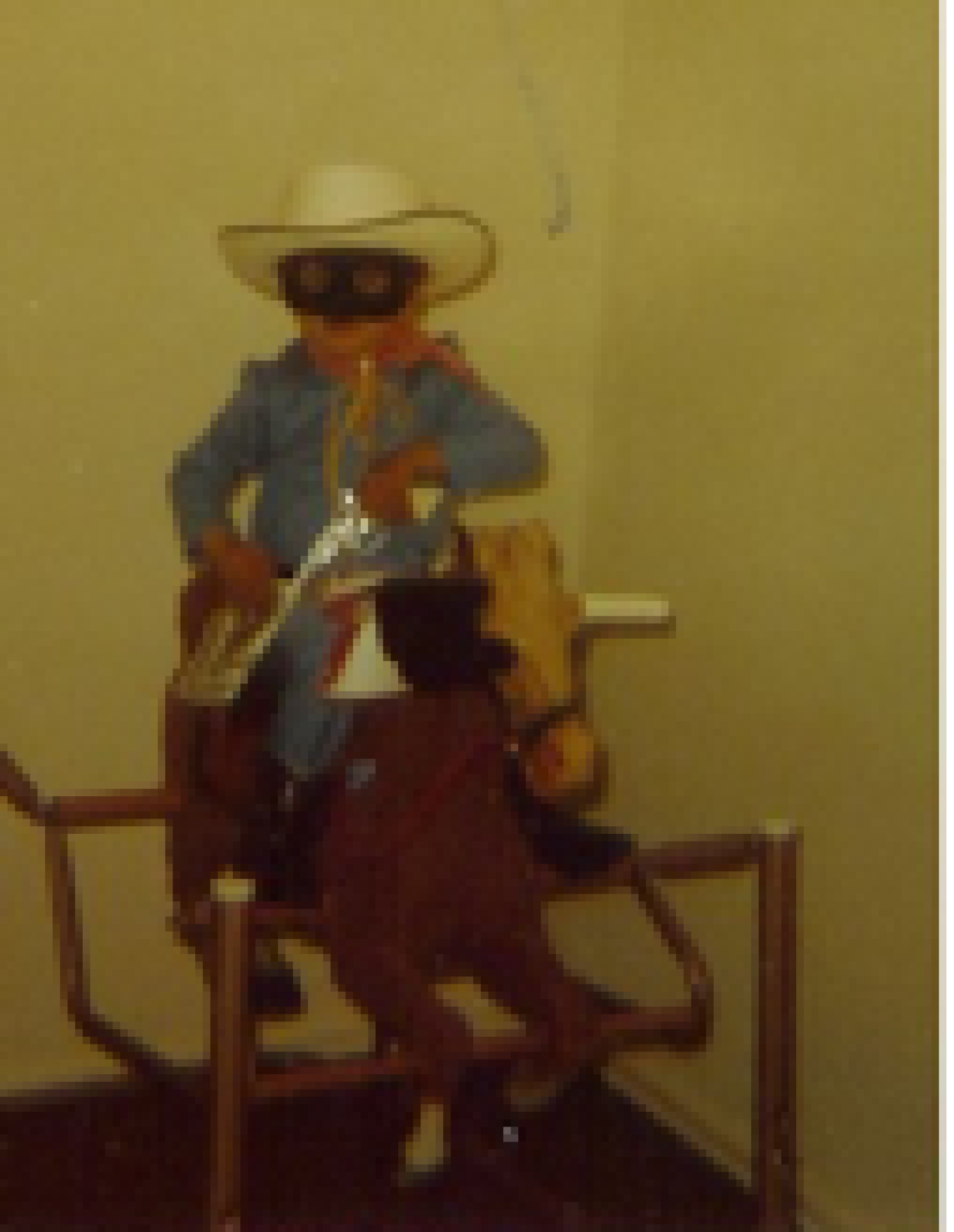
As a young boy, Curt was creative with language. He invented names for the bugs he caught in the backyard. Some he called “thunderbugs,” others were “source-a-nuts.” He drew pictures of bugs he called “poke-a-nuts.” Asked what a poke-a-nut was, he responded, “Well . . . it stings you, and it pokes you.”
His inventiveness wasn’t confined to naming bugs, however. As most children – and even some adults – do, if he didn’t know the exact word he wanted to use, he often settled for coming as close as he could. Climbing ropes at a church festival one day, Curt told me that he had to get under the rope for more “gription.”
His literal interpretation extended to more than one cake I baked for special occasions.
One morning, the five-year-old Curt got out of bed and sleepily made his way downstairs to the kitchen where I was frosting his father’s birthday cake.
“What’s that?” he asked me.
“Daddy’s birthday cake.”
“What kind is it?”
“It’s German chocolate, his favorite,” I responded, adding, “we’ll have ice cream, too.”
“Um, I think I’ll just have ice cream and no cake.”
“Why no cake?” I asked.
“’Cause that cake has germs!”
That was the year after his own birthday cake had been in the shape of a big foot with chocolate and coconut frosting and marshmallow toenails to honor his fascination with the yeti that was reportedly making tracks in the northwest United States. He refused to eat a piece of that cake, too, and even steered clear of the table as long as the cake was there. He applied this literal interpretation to most situations when he was young.
One Saturday afternoon when I returned from a trip to the grocery store, Curt and his father were watching an old black and white movie on television.
“What are you watching?” I asked them.
“Oh,” his father responded, “it’s just some old ‘B’ movie.”
“Unh-unh, Daddy,” Curt said, “it’s about ants!”
It didn’t occur to the six-year-old Curt that not all creation could understand the English language. He had the idea that he could communicate with everyone and everything in writing. He made a bird feeder, hung it in the maple tree in our front yard and attached this note:

“Real isn’t how you are made,”
said the Skin Horse. “It’s a thing
that happens to you. When a child
loves you for a long, long, time,
not just to play with, but REALLY
loves you, then you become Real.”
We talked about this philosophy during the last months of Curt’s life. It pleased me that a twenty-eight-year-old man wanted his Mom to read the story to him again.
During our evenings, I taught Curt to play Scrabble and Cribbage, as well as other games. He was competitive, and it was a good evening if he beat his Mom! I know there were many times when we laughed at his creativity in spelling and word usage during our Scrabble games. Once in awhile, he was adamant about making up definitions for his own words.
As much fun as we had playing games, bedtime was not negotiable in our house. Curt didn’t argue about it, but there were times when he attempted to delay it with a question or a story of his own to distract me. One night, after reading him a story and kissing him good night, I was turning out the light and just about had his door closed when he stopped me.
“Mom, Mom,” he called urgently.
“What?” I asked, opening his bedroom door again.
“Why do birds fly south for the winter?” he asked.
“Because it’s too far to walk,” I responded while closing the door.
“Mo-m-m-m,” he whined, “How did you know?”
Most of Curt’s childhood was happy. His father, however, too often crossed the line between discipline and child abuse. It was mainly for that reason that I divorced him in 1987. It was a difficult time for Curt. He told me years later that he thought our divorce was his fault. I know that he finally understood that it wasn’t, but he remained the typical abused child seeking approval from his abusive father to the last day of his life. It is a great regret for me that I was never able to help him understand the dynamics of his relationship with his father. He continued to bear the responsibility that rightfully belonged to his father.
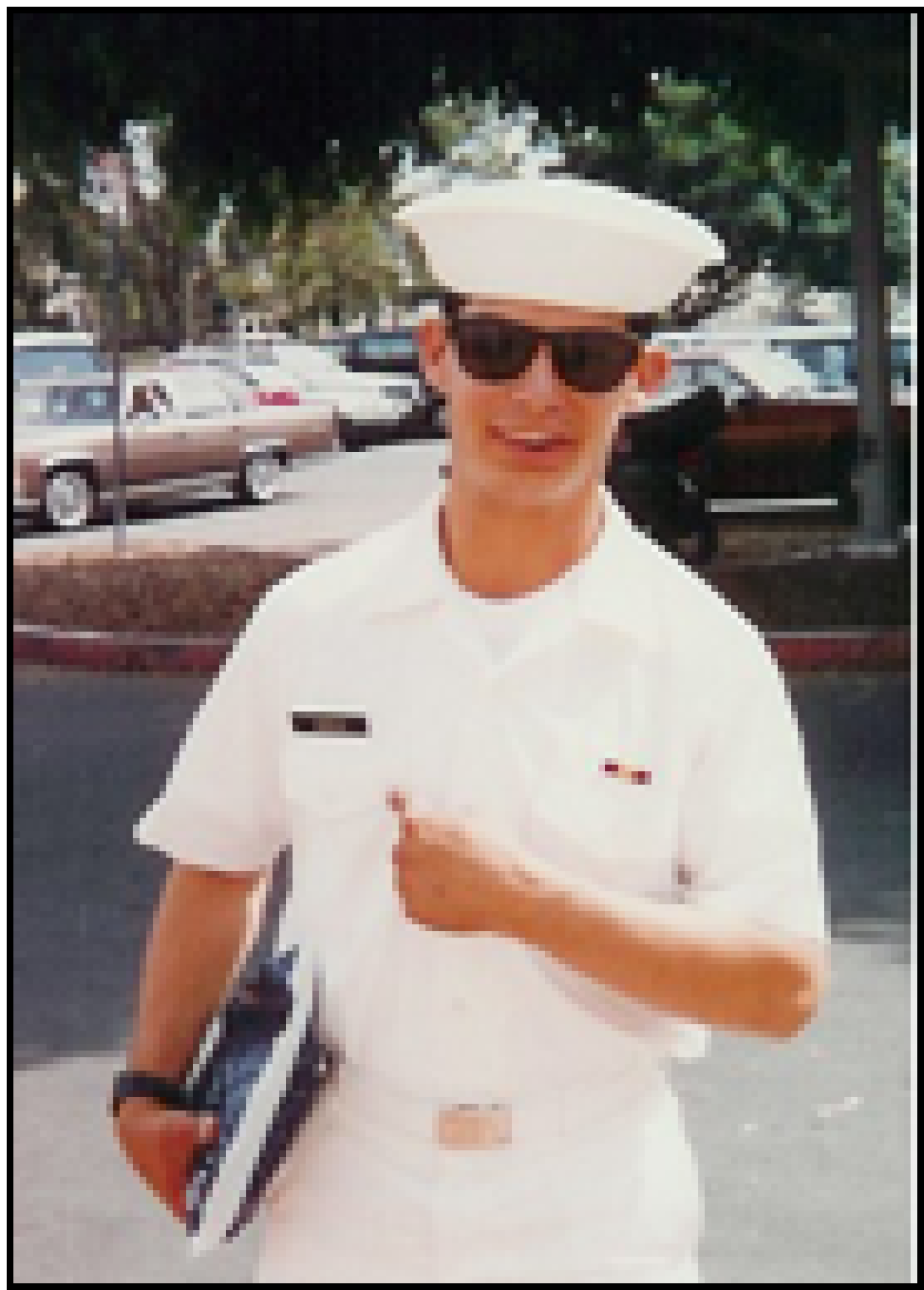
Submarine duty requires months at a time at sea; therefore, the Navy extensively tests recruits for health problems, especially blood-related problems. White cell counts decrease with the time underwater, and a recruit has to have normal white cell counts at the beginning of the duty to withstand the expected decrease.
After attending Curt’s “Pass In Review,” the graduation ceremony from recruit training on August 9, 1991, my husband Bob and I spent some time showing him the sights around San Diego. He was supposed to get an assignment to a school in New London, Connecticut, but he called me a few weeks later and told me that the hematologists had found a problem with his blood. He was discouraged, disappointed and worried.
I flew to San Diego and met with the hematologist who told me that Curt had “ethnic neutropenia” a deficiency of neutrophils. The “ethnic” referred to the fact that Curt’s father is Mexican, and, apparently, this particular mutation occurs more frequently in the Hispanic population. Neutrophils are one of about six types of white blood cells. They are the cells that help the body fight infections. The probable diagnosis from the Navy doctor was not encouraging and frightened both Curt and me, but we tried to be positive about that and about his future. We were also determined to enjoy at least part of my visit.
The last afternoon I was in San Diego, we went to the Museum of Science and Nature in Balboa Park. As I drove the rental car into the parking lot, Curt said, “I guess I can’t leave my Mom in the car.”
“Why?” I asked, smiling, “Did the sign say not to leave dogs in the car?”
“No, Mom,” he said seriously, “it said, ‘Don’t leave valuables in the car!’”
Later that afternoon, before I left the base, we hugged and cried. I told Curt that I loved him more than life itself. It was neither the first nor the last time he heard me say that.
I cried during the entire flight back to Denver, convinced that I needed to begin planning Curt’s funeral. It was one of the saddest trips I had made up to that point in my life. Having already lost J.R. in 1969 to Sudden Infant Death Syndrome, which has no symptoms other than death, I was determined to find out everything I could about the neutropenia and what, if anything, could be done to help Curt. I was devastated but not defeated, and I tried to make sure that he wasn’t defeated, either.
“Mudder,” he said to me during one telephone call, “it’s just awful to have the Navy bring my life to a halt this way. I wanted to be a nuclear engineer, like Bob.”
“Curt,” I tried to explain, “they haven’t put a halt to your life. Bob was in the Army. His education in nuclear engineering is from The University of Michigan, not the Navy. There are always many ways to reach a goal. You’ll just have to find a different way.”
I turned to my research training from the School of Journalism and Mass Communication and began gathering Curt’s medical records. With his signed releases, I had no trouble obtaining his medical history with the exception of his pediatrician’s records. She had died the previous year, and nobody seemed to know where to locate her records.
Desperate, I finally called the Medical Examiner’s Office for the State of Colorado. Personnel in that office provided me with the doctor’s last known address. They weren’t encouraging, though, telling me that the records only had to be kept for one year after the doctor’s death.
I wrote a letter and sent it to her last known address. I waited. Several weeks passed, and I was sure that I wouldn’t be able to obtain the records. However, after about a month, I received a phone call from the doctor’s partner telling me that she had located Curt’s record and would send it to me. I was euphoric.
With a complete medical history in hand, I made an appointment with my doctor. I explained to him what the Navy hematologist had concluded about Curt’s condition. He consulted with a hematologist who determined that Curt’s low neutrophil count was a lifelong condition.
“He’s had a low neutrophil count since he was an infant,” my doctor said. “He shouldn’t have any more problems with it,” he assured me, “but he should have his blood drawn a couple of times a year just to keep track of it.”
I thought we were home free, and that seemed to be the case for another nine years. Curt’s health was a normal as anyone’s, or at least that’s what we thought. He lived a pretty normal life for a man in his early twenties.
Following a medical discharge from the Navy, Curt returned to Denver and enrolled at Metropolitan State College majoring in Computer Information Systems. He worked part time at the college and went to school part time. I had always told him that even if I were rich, I wouldn’t pay his way through school. I had seen too many college students who wasted their time and their parents’ money, because the students didn’t have a personal investment in their education.
“There’s one thing I cannot buy for you,” I told Curt, “and that’s a sense of accomplishment.” I told him that I would help him with expenses, and we agreed that I would pay for his books each semester as long as he maintained a decent grade point average. He would work part time to earn the remainder of his expenses. Grades didn’t come easily for Curt, he worked and studied hard. He held up his part throughout the time he worked toward his degree, and I was proud of his efforts.
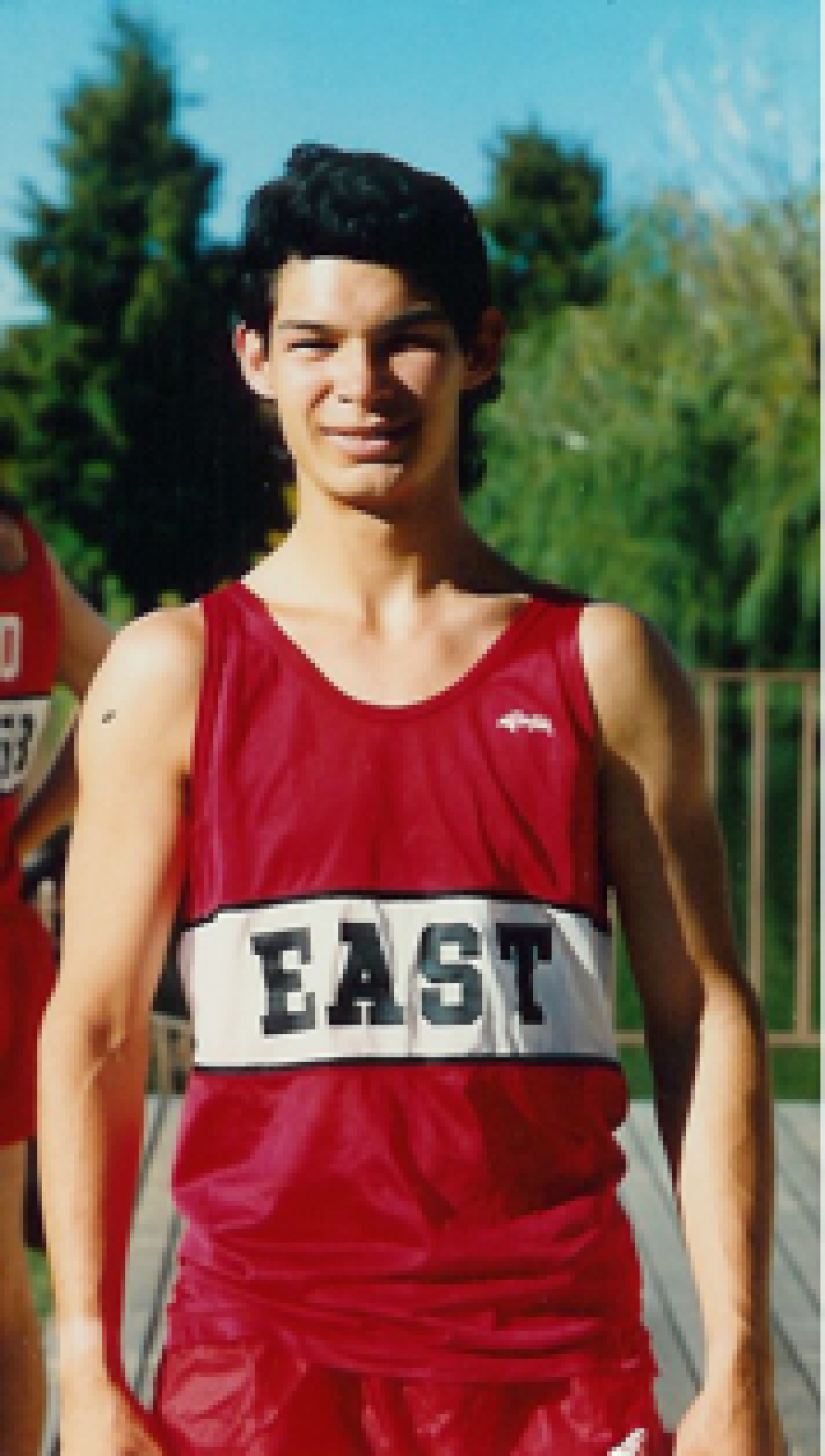
“What’s wrong?” I asked.
“Mom, I just wanted to make you proud, but I didn’t run very well.”
Sweaty as he was, I hugged him and said, “You don’t have to do anything to make me proud. I’m always proud of you.”
Although he never actually said so, I think Curt wanted to graduate from the same school as his mom. He eventually transferred to the University of Colorado at Denver and continued his studies while working part time at Safeway as a clerk at the service desk. He said that he often saw parents in the store with unruly children and asked them, “Wanna’ know how my Mom handled that when I was little?”
He would then tell them about a trip we made to our local King Soopers when he was three-and-a-half years old. I had always told him not to ask for things in the store, because then it was a sure bet that he wouldn’t get them. This trip, though, my sister-in-law and Curt’s two cousins were with us, so I guess he figured it would be worth a try. When I told him “no,” he fell to the floor belly side down and began to kick his feet, pound his fists on the floor and scream.
I looked down at him and said, “If you don’t stop that, I’m going to tell your mother that I can’t baby-sit for you any more.” I walked out of the store. He got up and followed me, and he never had another tantrum. As an adult courtesy clerk, he told the parents at Safeway that he thought it was an effective way to handle the situation!
In December, 1995, IBM offered Curt an internship in Rochester, Minnesota. He moved there in January, 1996, to begin the six-month assignment. His internship was extended several times, and when it ended, he worked for Ciber as a contractor to IBM in tech support.
We drove to Rochester to be with Curt for his first Christmas there in 1996, and he was home to visit many times during the five years he lived in Minnesota, especially the year before he died.
He had made plans to visit a pen pal in Colombia in January 1999, but he agreed to change the plans to be in Broomfield for my fiftieth birthday celebration January 10. Bob rearranged the itinerary. The airline gave him credits for the original ticket rather than change it, and we bought a new ticket. He flew to Denver for Christmas and on to Medellin right after, returning January 9 to help us celebrate my birthday the next day.
In retrospect, I believe that rearranging that trip was fate. Many of our friends saw Curt for the last time at my birthday party, and the airline credits for the original trip made it possible for him to come home to Colorado for almost every major and minor holiday in 1999.
When Curt was growing up, I always baked cinnamon rolls on Christmas Eve after he went to bed. During his Thanksgiving visit, he told me that Christmas for him meant Mom’s cinnamon rolls. He couldn’t make the trip home for Christmas, so I baked cinnamon rolls on Christmas Eve and sent them overnight to Rochester. We were talking on the telephone when the postman delivered the rolls the next morning.
“Now, it’s Christmas!” he said.
I told him that with the postage figured in, those were the most expensive cinnamon rolls he would ever eat! Since that turned out to be his last Christmas, I am truly grateful that I baked and sent the rolls that year. If I had waited for another opportunity, I would have regretted it for the rest of my life.
Ciber cut Curt’s contract and laid him off on February 14, 2000. He went to work at Hy-Vee Supermarket as an assistant manager in March. His prior experience with “Slaveway,” as he called it, obviously helped him get the new job.
During a phone conversation right after he started working for Hy-Vee, Curt told me that he’d had a sore throat he couldn’t seem to shake. I advised him to get it cultured to make sure it wasn’t strep. He had the culture done and called me back.
“I have some good news and some bad news, Mom,” his typical conversation starter, “which do you want first?” he asked.
The good news was that he didn’t have strep. The bad news was that the doctors had identified a problem with his red blood cells. “You’d better follow up on that,” I told him, “given your history with blood problems.” I wasn’t overly concerned, though, since his problem was with white cells.
To make a very long story short, Curt developed a horrible backache at work one day in May. He went to the emergency room at the Mayo Clinic. The doctors looked at the blood work and in about a week gave him a diagnosis of myelodysplasia, which is a rare form of leukemia. The hematologists at Mayo told me that, although they treat thousands of patients from around the world, they only see about two cases of this type of leukemia each year. Curt’s bone marrow was failing to make mature blood cells of any kind. Caused by a longer arm on one of the chromosomes in his blood, this was, the doctors said, a progression of the problem the Navy identified in 1991.
Curt’s only hope for a cure, the doctors told us, was a bone marrow transplant. With the transplant, he had a thirty percent chance of survival. Without it, he would die. The best match for a bone marrow donor is an identical twin. The second best match is a sibling, but each sibling has only a twenty-five percent chance of matching another sibling. Since Curt had no surviving siblings, his donor would be from the general population registry at the National Marrow Donor Program in Minneapolis.
Curt was understandably scared – terrified might be a better description for his emotional state, but he handled all of it with faith, strength and courage.
That summer, while waiting for a bone marrow donor to be identified, he received many transfusions of both platelets and red blood cells on a semi-weekly basis. White cells cannot be transfused, because the body normally replenishes white blood cells constantly. White cells are only viable for about 24 hours, which isn’t long enough for them to be transfused. Since these are the body’s defense against infections, Curt’s immune system was compromised. He spent much of his time in the hospital trying to ward off potentially fatal infections.
Unable to sleep one night, Curt went to the nurses’ station and wrote the following essay about the phlebotomists who were constantly drawing blood samples for necessary testing.
Vampires
The only drawbacks are the vicious midnight Vampires that stalk their prey just before sunrise while their innocent victims sleep and dream of peaceful moments on the beach and summertime vacations. Stealthily they slowly creep into the dark room, lurching and salivating from the deprived hunger gurgling within their bottomless, rancid stomachs. They glance down at their prey nestled snug and deeply sleeping. A thin smile rises from their evil little twisted lips and their dark shadowed eyes widen in delight for they know that the banquet is about to begin. Their sharp piercing fangs descend eerily upon the soft vibrant flesh then at the right moment when all is silent and calm they viciously strike out in ruthless terror, devouring their victim in frightful pain and unnerving agony! Though one ruthless and gleeful Vampire tyrant dominates his innocent and terrified prey, hundreds of voices are heard singing cruel and vile chants in the background . . .
Patients reap the sorrows of pleasure, your life is mine to torture forever. Crying vengeance, weeping state, manic depression, eternal fate. Darkness triumphs we have won, this sacred massacre which we’ve begun. I am your Vampire whom you shall trust; the false truths told obey you must. You shall live to die in vain. Your life, your soul, your hell, your pain.
. . . and then all at once the voices slowly fade away into nothingness. When at last the predator has had his fill and the victim lies near a comatose death, the Vampire arches his back bellowing a loud echoing laughter, relishing in the magnificent satisfaction of another exquisite feast. That one more innocent life has been successfully tortured and terrorized an at last he can finally vanish from whence he came into the darkness of the now cool and still night before the newly rising sun welcomes this pestilence to his own fatal demise.
Now that’s how I feel about phlebotomists and that’s all I’ve got to say about that!
Addendum: My nurse Sarah gave this to the Vampire before she entered my room. The Vampire Haven (blood lab) wrote on my record; let patient sleep. Instead of waking me at 4am, they waited until 7am. I should write these every night!
One morning, Curt told me that he had been awakened in the middle of the night by a “vampire” who was checking his ID bracelet.
“What are you doing?” Curt asked.
The phlebotomist said, “I am checking to see that you have the right name.”
Curt responded, “It’s the right name. It’s the one my Mom gave me when I was born.”
The bone marrow donor was identified, but I’m not certain that the match was a close as it might have been. Curt’s body was reacting adversely to the platelet transfusions, which were becoming more and more frequent. Numerous dark red patches of hives appeared first on his sternum, then on his legs and sometimes on his arms. The doctors ordered irradiated platelets. Curt reacted adversely to those, too. They changed the order to HLA matched, irradiated platelets, which also caused the adverse reactions.
Human Leukocyte Antigens (HLA) are proteins present on the surface of white blood cells and most other cells in the body. They allow the immune system to distinguish “self” from “non-self.” If the donor’s antigens don’t match those of the recipient in the bone marrow transplant, a condition known as Graft Versus Host Disease occurs, in which the transplanted cells reject the patient as “non-self.” It is my understanding that in routine blood transfusions, there is no HLA typing necessary, because the immune system isn’t compromised. In Curt’s case, however, the HLA typing was necessary, but was insufficient to prevent his adverse reactions.
On Wednesday, September 6, the hematology consultant told me, “We have to go ahead with the transplant. We’re running out of time.” That’s why I suspect that the donor match wasn’t as close as it might have been.
The bone marrow transplant procedure requires preparation of the patient to completely eliminate his own marrow. Three days of strong chemotherapy were followed by three days of full body radiation – two treatments each day added up to a fatal dose of radiation, so Curt received a total of three fatal doses of radiation prior to the infusion of the donor marrow on the sixth day. I believe that the hope is that the donor’s marrow will begin making blood cells before the radiation sickness kills the patient.
As difficult as it was to watch Curt go through all of these extreme procedures and the radiation sickness, he faced all of it with so much optimism and fortitude that it was impossible to reflect anything but his optimism. He was positive that he would survive.
More than a year after Curt died, a former sister-in-law said to me, “If you had known how this was going to turn out, you probably wouldn’t have had Curt.”
Absolutely wrong! Curt was a gift to me from God. Although I obviously wish that his life had been much longer, I wouldn’t have given up any of the time I had with him or any of our experience together for anything. I know he would agree. Surviving one’s children is not the natural order of things, but because a gift doesn’t last as long as we expect, we cannot reject the gift itself. My life would have been poorer without the gift of Curt. It saddens me more than I can express that I will never answer the phone again and hear him ask, “Hey, Mudder, how’re you doing?” or, “Hey, it’s meeeee calling youuuuu.”
Curt gave me so many wonderful memories with which he continues to enrich my life every day. Many simply make me grin.
Having had a difficult kindergarten year, I had requested that John Ortner, the Principal at Emerald School, assign Curt to an easy-going first grade teacher. Not knowing how those assignments are made, I always assumed that Mr. Ortner complied by placing Curt in Mrs. Aletha Borgmann’s class.
Curt got off the school bus one spring day in tears. This had not been unusual during kindergarten, but it was not normal for first grade. I asked him what was wrong and got a tearful account of all the things he had forgotten to bring home from school that day. I told him that we could go to Emerald and retrieve his things.
When we got to Mrs. Borgmann’s classroom, she told me that the end of the day had been rushed, and she had hurried the children out of the building at the last minute, so that they wouldn’t miss their buses.
Curt went to his desk and gathered up all the papers he had forgotten along with his “show and tell” item. I asked him if that took care of everything. He sort of hung his head and said a half-hearted “yeah,” but it was obvious that something was still wrong.
Mrs. Borgmann called him around to her side of her desk. “Did you miss your hug?” she asked him. He nodded, and she gave him a big hug. Finally, he lit up! He skipped off toward the car and everything was right in his world. Aletha Borgmann truly turned his school experience around in the most positive and loving way of a great teacher. I will always be grateful for her wonderful skills and influence.
One of my favorite memories occurred the next year when Curt was in second grade. The bus stop was on the corner just outside our front door. He would mess around every morning and run out just in time to board the bus. I told him that one day he was going to dawdle too long and miss the bus.
“When that happens,” I told him, “I’m not going to drive you to school. You’ll have to walk.”
His school was about two-and-a-half miles from our house. Sure enough, one morning he ran out the front door and came back in, dejected.
“The bus just left,” he reported.
“Well,” I told him, “you know what to do. Walk the same way your bus goes and call me when you get to school.”
“Mo-m-m-m,” he pleaded.
“I told you that I wasn’t going to take you if you missed the bus because you were messing around.”
He left on foot, and I called the school secretary to let her know that I had asked him to call me when he got to school. About thirty-five minutes later, the phone rang.
“Mom,” he panted, out of breath, “I’m here.”
“Good,” I said. “Did you learn anything?”
“Mom,” he said, exasperated, “I just got here!”
How did he get there so fast? That was years before I started running, so it didn’t occur to me that thirty-five minutes was way too fast for a second grader to cover two-and-a-half miles, but years later, he told me that he had hopped on the back of a garbage truck and rode much of the way to school. I’m glad it didn’t occur to me at the time!
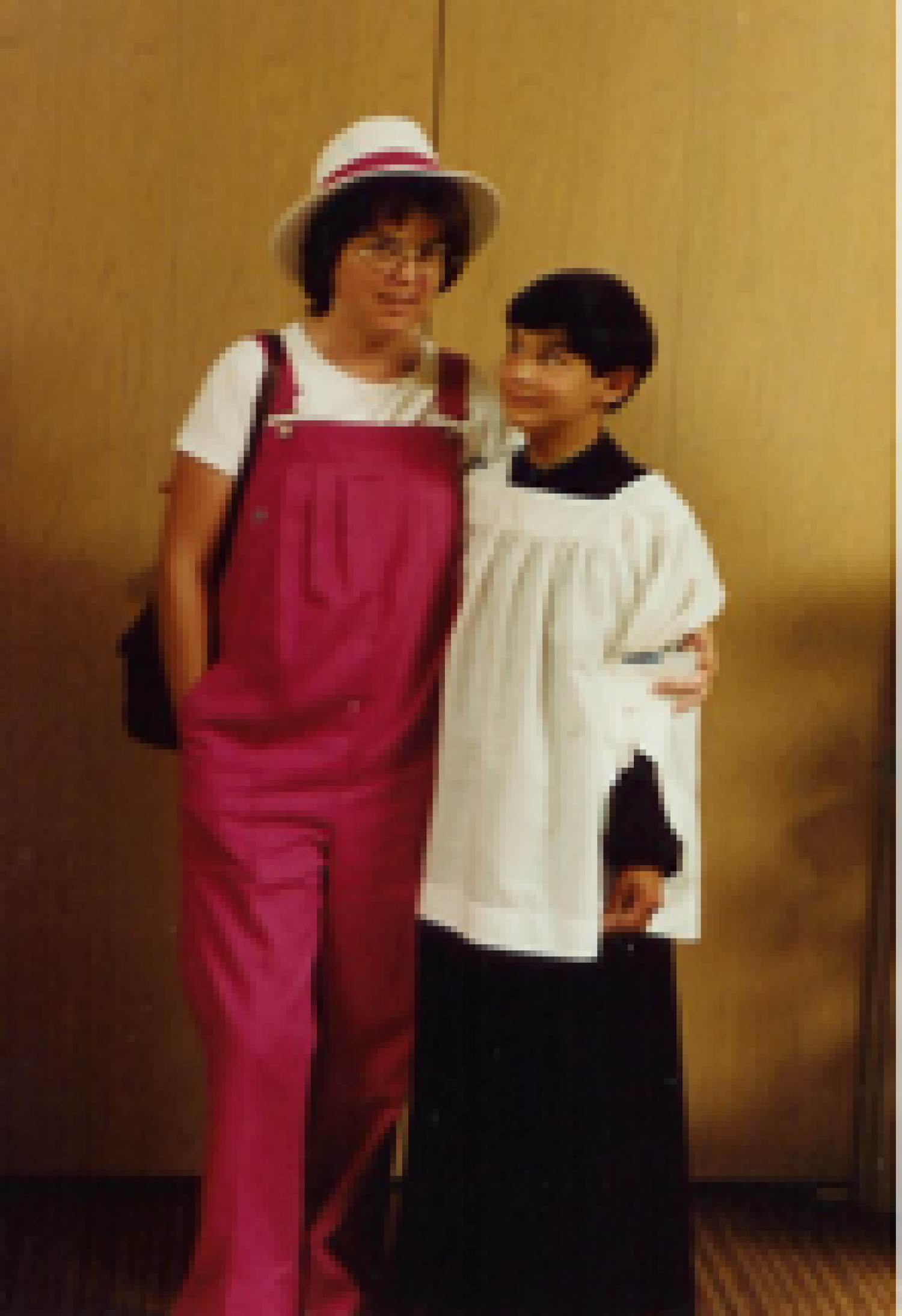
When he was a student at Nativity School in seventh and eighth grades, he still got up early and served Mass before going to school. He also served daily Mass during his summer vacations, and when he moved to Denver, he was an adult altar server at The Cathedral of the Immaculate Conception.
In the 1987 final edition of the Royal Review, Nativity of Our Lord School’s newsletter, Curt’s review of the year and his future plans are described: “Looking back, Curt Gimeno says his most memorable time here was going to the speech meet for the first time and making the semi-final round and winning almost everything at field day. He plans to go on to Broomfield High School and then to CU. Curt looks forward to being a priest when he gets older.”
He used to threaten me when he was a young altar server that if I didn’t behave myself, he would be a priest when he grew up, “and then you won’t have grandchildren!”
Against his father’s wishes, I transferred Curt to Nativity School and had him repeat the seventh grade because the Middle School wanted to promote him to eighth grade even though his final grades were abysmal – all below Cs. Going on to eighth grade without doing well in seventh, I believed, was setting him up for failure. He told me later that it was one of the best things I had done for him.
Discussing his mid-year middle school report card, I told him, “Curt, you got a D in English. There is no excuse for that. All you have to do is show up for class and turn in your homework, and you’d get a C. If you put forth a little bit of effort, you could easily get a B.”
“Mom,” he tried to convince me, “I got a D in English because I’m Mexican.”
“Sorry, son, that won’t work because, look here,” I said pointing to a particular grade, “you flunked Spanish.”
He laughed. It had been worth a try.
With smaller class sizes at Nativity and positive peer pressure, Curt progressed well in his studies. He wrote the following essay for a school publication:
Basic Uses and Abuses of Communication
by Curt Gimeno
Communication is used everywhere in society. Communication skills are very hard and complex to learn. Interferences, hidden messages, and the levels of talking all prevent effective communication.
Interferences stop or slow down messages by others. Some interferences are noise, past and present experiences, people, actions, and rumors. Verbal and nonverbal communication are distractions because many people don’t know how to use them. The environment is a basic interference. People should listen to what is being said and think before acting. The hidden message is a very emotional state of communication. This kind of communication can result in game playing.
The levels of communication can also be a distraction. A couple of solutions that could be used for this kind of problem are easy to use. First, go into a room with few distractions. Second, sit down and feel comfortable. Next, have eye to eye contact with the other person. Finally, express all feelings and facts on the subject and give reasons.
All communication, verbal or nonverbal, emotional or levels are complex. There are many problems in reaching good communication. We need education to improve our skills. We would then be happier people.
– 8th grade essay published in “The Write Road,” Nativity of Our Lord School, 1986-1987
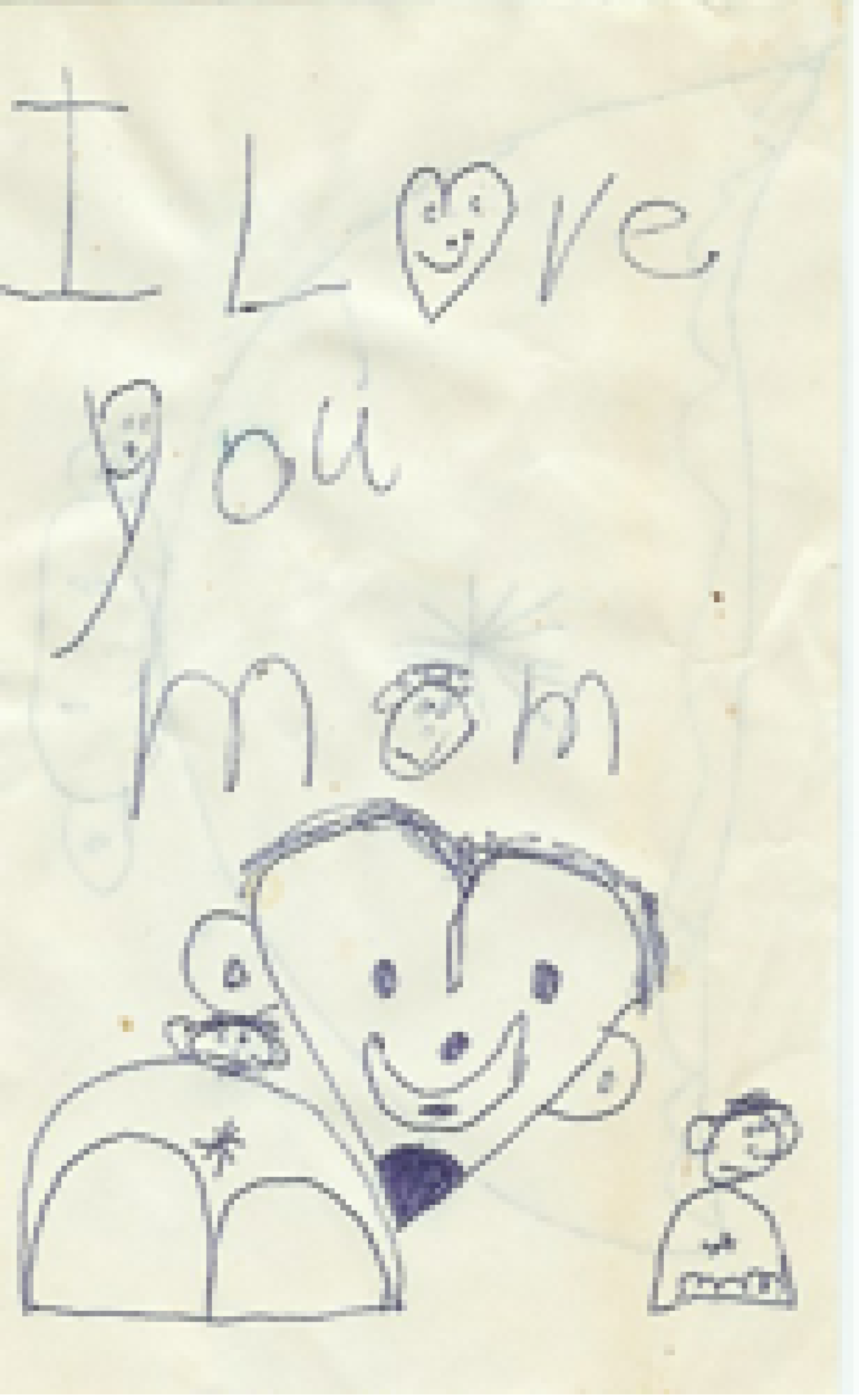
From the time he was a little boy, Curt had a marvelous sense of humor. He saw the light-hearted in most situations. During one of his many hospital stays the summer before his death, he and I were playing Cribbage in his room. He miscounted a hand and began to laugh when he saw the expression on my face, which he later told me, tickled him. Because he was laughing, I started laughing. We had tears rolling down our faces from laughing so hard. I don’t know about him, but my abdominal muscles were aching, and when we finally gained some control, he looked at me and said, “Mom, you make life fun!” He was the one who made my life fun and worth living.
As deeply as he cared about other people, Curt didn’t meet many strangers in his nearly 29 years. He opened his home to people who had no place to go, including a woman from Morocco whose boyfriend was mistreating her, a former general in the Sudanese army and others. Curt truly lived the Gospel of Jesus Christ.
He organized IBM’s first Hispanic and Latino Diversity group in Rochester. The purpose of the group was to “promote Hispanic heritage with a social responsibility and a desire to improve the quality of life for all people by striving for excellence through integrity, education, diversity and continuous improvement,” Curt wrote in their mission statement. “The group was started to educate members on diversity issues, schedule community service events and provide an effective outreach program for new employees and people within the community.”
With his friends Dolly Gonzalez and Jose Calva, he also co-founded an organization called Juntos, which means “together” or “jointly,” to provide after school tutoring for Hispanic elementary school students in Rochester. In the spring of 1999, Juntosstarted with six students and as of the end of 2001, according to Dolly, had grown to include 183 students.
It was not unusual for Curt to exhibit this kind of caring and concern. From a very young age, he amazed me with his compassion for others. I remember the toddler who comforted me when I was upset. Climbing up on my lap, putting his arms around me, and patting my back, he told me, “It will be okay, Mommy.”
He consistently felt this kind of compassion for others. Their hurts became his to comfort, and later, he would literally give away money he needed, if he felt that someone needed it more than he.
When the dog and childhood companion that had been part of Curt’s life for 14 years had to be euthanized in 1994, it broke Curt’s heart. He wrote the following poem about his sadness over that experience.
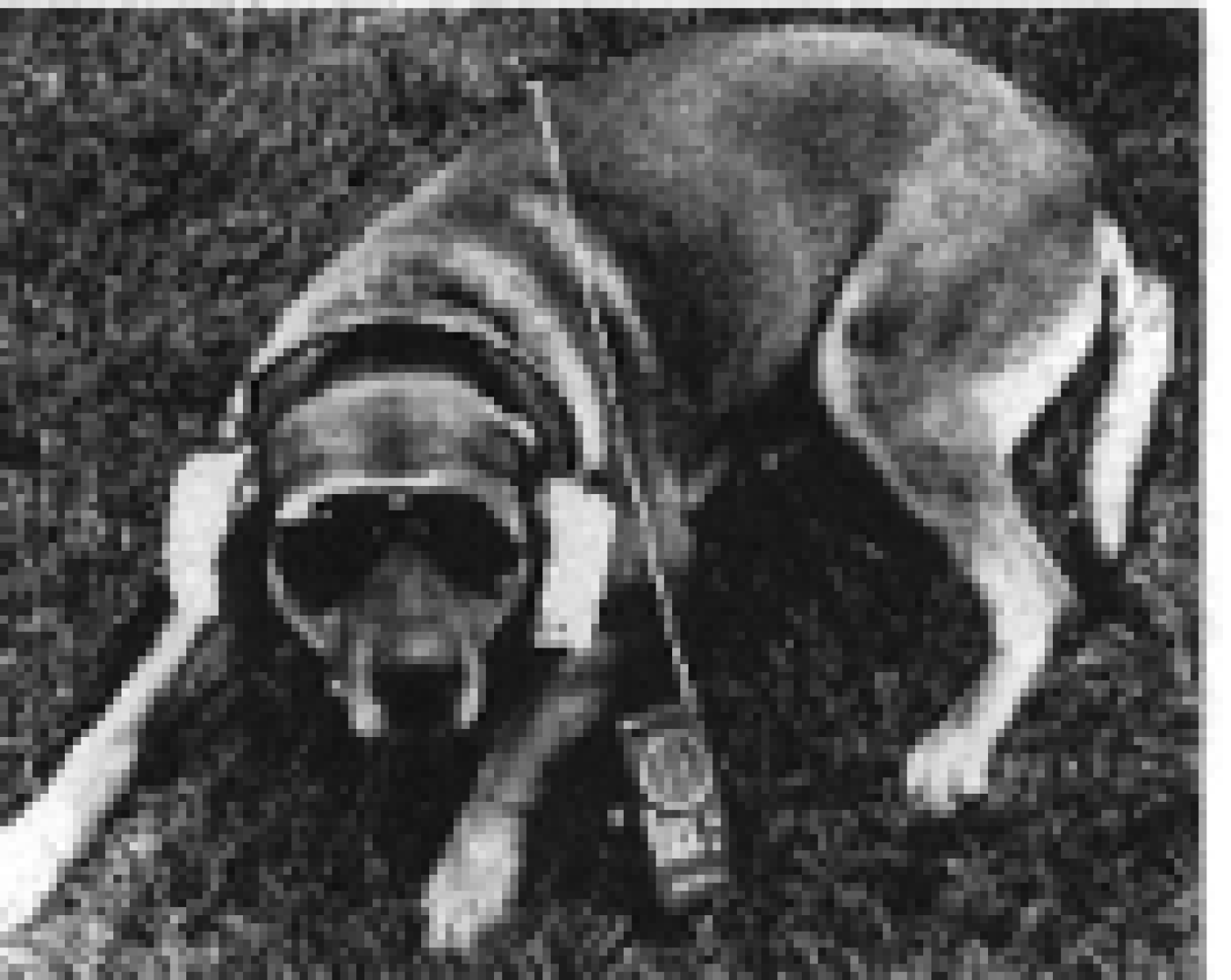
Whenever new life arises, death is imminent.
A flower may sprout quickly,
Blossom and bloom in all radiant colors,
Though Thanatos prevails in the end.
Life is death and death becomes life.
Explain life? Life is love, Life is companionship.
Life is trust and loyalty to oneself and others.
A giver of life is eternally joyful. Likewise,
A giver of death yields compassion and sorrow.
Life and let live, die and let die.
I thank the one who gave life to my friend.
Our life threads crisscrossed so elegantly.
For good and bad times, you were always there.
At your side I held you close to my heart.
When you died, a part of me went with you.
Now loneliness prevails in a dark and empty world.
Laughter is not so readily welcome.
Parallel highways end, while a new trail begins.
Remembrances of you are all I have left.
Wait for me.
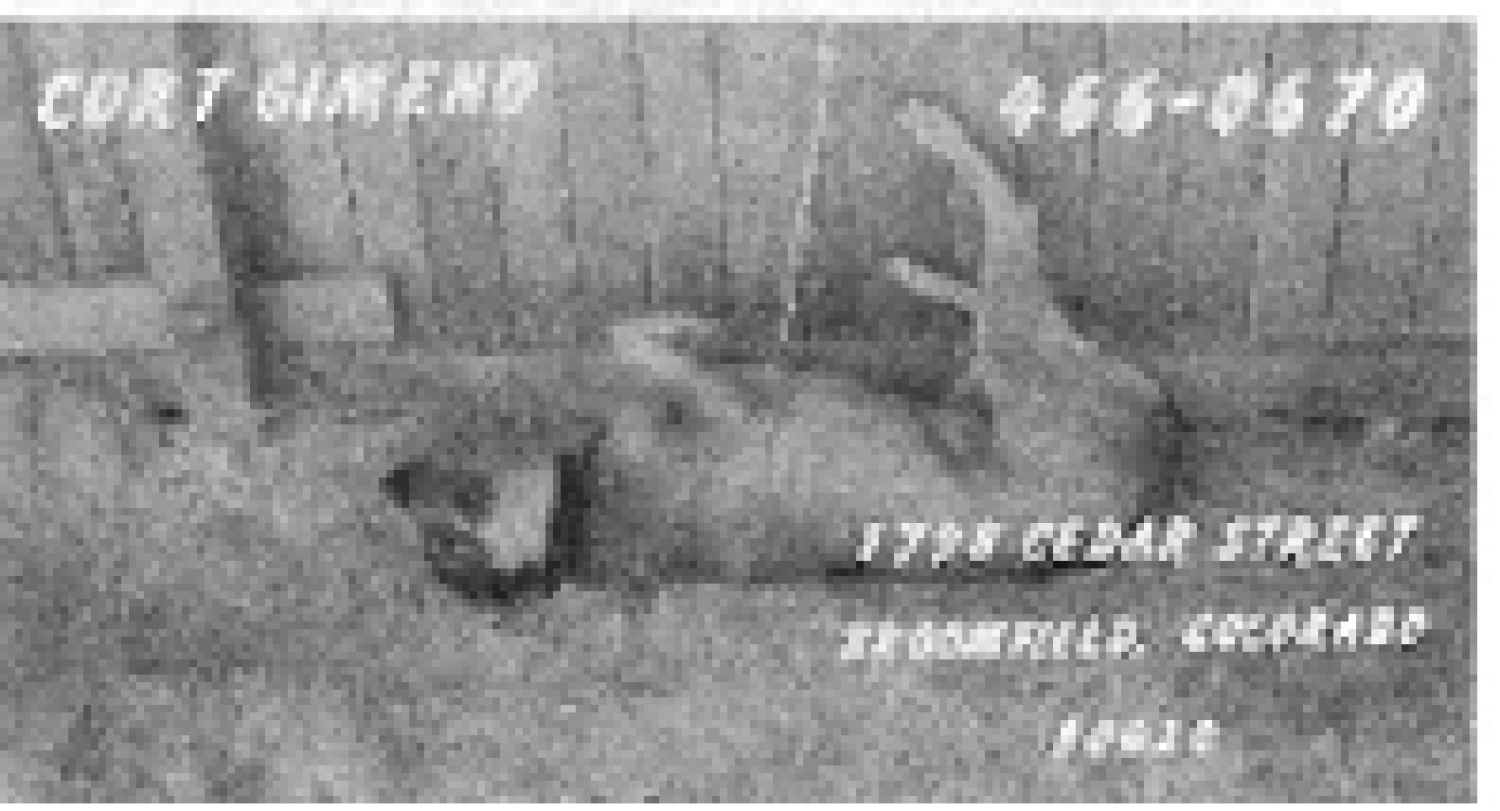
Never one to rush through anything, he told his friend Dolly Gonzalez that he wasn’t in a hurry to finish college. “I have plenty of time,” he would say, “my Mom didn’t finish her degree until she was thirty-nine.” He was proud of that.
Of all his attributes – kindness, compassion, sense of humor, athleticism, faith, photography skills, strength and courage – I admire Curt’s courage most. Courage, according to Webster, is that quality of mind that enables us to face dangerous situations with confidence. Curt did that. The courage he showed in facing leukemia was truly admirable. He was afraid – courage is not the absence of fear – but he still faced it all with strength and confidence.
His trip to Colombia to meet his longtime pen pal Marisol Ramirez and to celebrate the New Year 1999 with her was courageous. Considering the cultural and political situations in Colombia, I would have been terrified to attempt such a trip. I tried to discourage him from going, but he flew to Bogota with confidence. To my great relief, he returned home safely. I am so glad now that he made the opportunity to take that memorable trip.
It is my hope that the funds provided by this scholarship in Curt’s memory will continue to accomplish the goal he stated for his life:
“I try to live my days knowing that I positively affected someone else’s life here.”
The Curtis Michael Gimeno Memorial Scholarship was originally gifted to the School of Journalism and Mass Communication in 2001 and transferred to The College of Arts and Sciences, Creative Writing Program in the English Department in 2011.
Copyright © 2002 by Donna Jorgenson Farrell
Revisions 2003, 2004, 2008 and 2011
All rights reserved. No part of this publication may be reproduced in any form or by any electronic or mechanical means, including information storage and retrieval systems, without permission in writing from the author, who grants this permission to the English Department to make copies available to recipients of the Curtis Michael Gimeno Memorial Scholarship.


